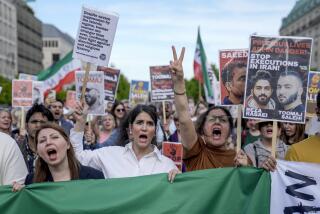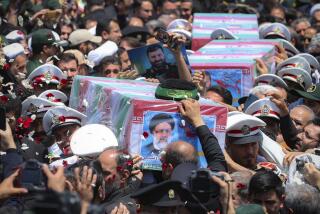Popular dissident Hossein Ali Montazeri mourned in Iran
- Share via
Reporting from Tehran — Thousands of supporters of Iran’s most senior dissident cleric marched through streets in his hometown and descended upon the country’s main theological center Sunday to mourn his passing just days before the climax of a politically charged religious commemoration.
Ayatollah Hossein Ali Montazeri, a pillar of the Islamic Revolution three decades ago who became a staunch defender of the nation’s current opposition movement, died late Saturday of complications from advanced age, diabetes and asthma, his doctor told state television. He was 87.
His death could further galvanize the protest movement that grew out of disputed presidential elections in June but that has been driven as much by raw emotion over perceived injustice as by rational political calculation.
Montazeri was an important figure in Iran’s post-revolutionary period, a widely respected and creative Islamic jurist and political theorist. He had been slated to take over as the country’s supreme leader before a falling-out with Ayatollah Ruhollah Khomeini, the founding father of the Islamic Republic, over killings of political prisoners in the late 1980s. Montazeri became a harsh and defiant critic of the revolution he helped create.
“Ayatollah Montazeri will be remembered in the history of Iran as brave, open-minded and willing to say the truth at any time, even when encountering danger,” Fazel Maybodi, a mid-ranking reformist cleric and a well-known disciple of Montazeri, said in a telephone interview from the city of Qom, the country’s religious center.
“He was a faithful source of emulation in Islamic jurisprudence who initiated a huge change in the mentality and attitudes of the senior clergy,” Maybodi said. “He braved all threats and dangers to honor his commitment as a senior cleric.”
His death comes as the opposition prepares to hold protests to coincide with the emotionally charged Muharram ceremonies marking the 7th century martyrdom of Imam Hussein, a grandson of the prophet Muhammad and a highly revered figure within Iran’s majority Shiite Muslim faith.
Adding to the potential for unrest, the religiously significant seventh day after Montazeri’s death will fall on Ashura, the often-frenzied culmination of Muharram, when Shiites pour into the streets to beat their chests and weep in ritual mourning of Imam Hussein.
Opposition leaders Mir-Hossein Mousavi and Mehdi Karroubi declared today a national day of mourning and called on Iranians to come to Qom, where the ayatollah died and is scheduled to be laid to rest during the day at the shrine of Fatemeh Masoumeh, the second holiest site in Iran.
A witness in Qom this morning described thousands of people crowded along and around the small street outside Montazeri’s home, preparing to take part in the funeral march to the city’s shrine.
“Oh Hossein, Mir-Hossein!” the mourners chanted, in support of opposition leader and former presidential candidate Mousavi, who had arrived at the late cleric’s residence Sunday night.
Already on Sunday the roads leading south out of Tehran were clogged with traffic as opposition supporters and others headed to the shrine city to pay their respects. Residents and students in the city of 1 million began text-messaging and e-mailing friends in the capital to invite them to stay at their homes overnight.
Traffic to Qom early this morning was heavier than normal. A witness near the city’s shrine described a massive police presence, but no boisterous demonstrations as of 9 a.m.
The reformist website kaleme.com said dozens of opposition supporters had been arrested en route to the funeral.
Clerics and seminary students crammed inside and outside Montazeri’s home to extend condolences, two clerics said by telephone Sunday.
On the restive campuses of Tehran, students gathered to mourn Montazeri, according to witnesses and videos posted to the Internet. The main market and schools of Montazeri’s hometown, Najafabad, shut down as thousands holding black flags marched through the streets.
“Dictator! Dictator!” they chanted, according to video posted to the Internet. “Montazeri’s path will continue.”
Security forces spread out along Tehran’s main squares and were reportedly swarming Qom to head off any unrest. At least one student of Montazeri, Ahmad Qabel, was arrested en route to the shrine city, a reformist website reported.
State-controlled television carried minimal coverage of his death while reformist websites inundated the Internet with photographs of mourning ceremonies, minute-by-minute developments and remembrances. Ayatollah Ali Khamenei, who succeeded Khomeini as supreme leader, offered his condolences to Montazeri’s family while pointing out the key role the cleric had played in creating the ongoing rift within Iran’s establishment.
“For a long period of his life he had been at the service of the [Khomeini] movement,” Khamenei said in a statement published by the official Islamic Republic News Agency. “In the later part of his life there was an ordeal that I wish almighty God will forgive and conceal, and that his worldly suffering will be atonement for that.”
Born in 1922, Montazeri pursued his religious studies in the seminaries of Qom. The scholar and theologian organized clergy to oppose the monarchical regime of the late Mohammed Reza Shah Pahlavi, spending several years in prison during the 1970s.
After his split with Khomeini, cast out of Iran’s inner circle of power and stripped of his official posts, the small, bespectacled cleric over the last two decades became an outspoken critic of the Islamic Republic, calling for greater democracy and respect for human rights and civil liberties while often being kept under surveillance in conditions that resembled house arrest.
Nonetheless, he served as an influential spiritual guide to the reform movement that peaked in the late 1990s during the presidency of Mohammad Khatami.
His stature and relevance further rose after the disputed vote, when he became a strong advocate for the opposition movement and challenged the Islamic Republic’s legitimacy.
“A system which has been acting under the aegis of Islam and has the honor to be Shiite has created distrust toward Islam and religion not only in the world, but also among [our own] people and our young generations,” the ayatollah wrote in a letter posted to a reformist website in September. The system “has depicted Islam as unable to implement justice in society.”
In the last months of his life, Montazeri offered religious approval to those opposing the government, urging fellow clergy to stand with the Iranian people just as they had in the face of all “oppressive” regimes.
“The regime has savagely suppressed million-strong protesters who were legally objecting to the election outcome,” he wrote in September.
“The grand ayatollahs are well aware of their influence on the regime, and they know quite well the regime needs their approval for its legitimacy,” he continued. “Their silence may give the wrong impression to people that the grand ayatollahs approve of what is underway.”
Last month, he warned members of the pro-government Basiji militia that their violence against demonstrators was not religiously sanctioned.
“It would be a misfortune to go to hell for the sake of the worldly desires of others,” he said, according to reformist websites.
Several years ago, a reporter asked Montazeri whether he would support the Islamic Revolution again if he could turn back the clock. He went silent for a few moments as he considered his response.
“No,” he finally replied.
Mostaghim is a special correspondent.
More to Read
Sign up for Essential California
The most important California stories and recommendations in your inbox every morning.
You may occasionally receive promotional content from the Los Angeles Times.










